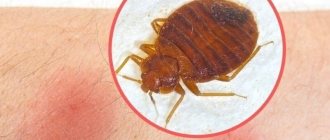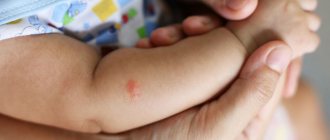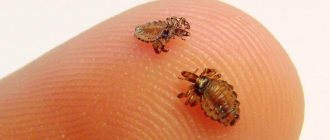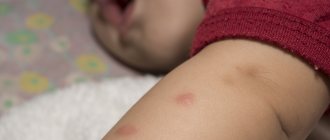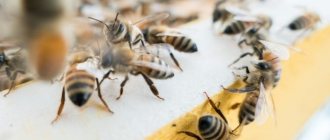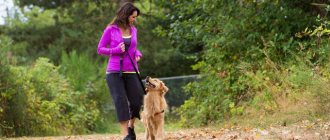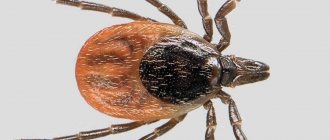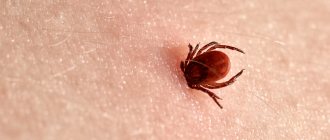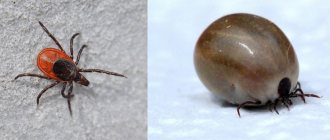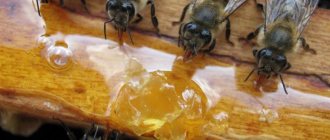The first troubles and even ailments that we encounter in nature with the onset of warm weather are insect bites. We recently dealt with tick bites, and there are bites from wasps, bees, and mosquitoes ahead. How can they be dangerous and what should you do if you or a child are bitten and develop a severe reaction to the bite?
Who do mosquitoes love?
To be honest, I didn’t understand the hype around mosquito bites before and why everyone is so afraid of them. But one day we found ourselves in the wilds of a very dense forest. The mosquitoes there never saw people. At first I didn’t even understand why there was such background noise in the forest. And they were the ones squeaking. And no repellents bothered them at all - they were so hungry.
When we cooked buckwheat over the fire, the hungry insects went completely crazy. They rushed into the warmth of the boiled porridge and stuck their proboscis into it. It became clear that at night we would all simply be gnawed to the bones, and we hastily retreated to another place.
After that, I realized that a lot depends on the area of residence, the season, the level of hunger of mosquitoes, the person himself and his psychological fortitude. Some people get bitten more, some less. I’m not sure whether mosquitoes love any particular blood type more, but it’s a fact that they flock more actively to a person who sweats a lot. They hardly touch me, I hardly even use sprays, but my husband just goes crazy from the bites and rushes through the blueberry thickets like a bull maddened by horse flies.
And of course, there are people with a pronounced reaction to mosquitoes; children with delicate and sensitive skin often suffer.
Fleas in bed
In addition to bedbugs and mosquitoes, there are other parasites: for example, fleas. Flea vinegar is similar to mosquito vinegar. It differs from a mosquito puncture in its smaller size and quantity. Flea bites are usually concentrated in one area. They are very itchy, swollen, and red. In addition, scratches can become inflamed and pathogenic microorganisms can enter the wound.
What are there
There are more than 2,500 species of fleas that specialize in different animal hosts. Usually they rarely change owners, but in the absence of food they can choose another victim. Several species are dangerous to humans in our latitudes.
- The human flea (pulex allerans) has been virtually eradicated, but can occasionally be found. She mainly lives in beds, carpets, upholstered furniture and leaves the nest to drink blood.
- The cat flea (ctenocephalides felis) lives on cats and in their habitats. It is transmitted to dogs and people, as they are much less attached to the owner.
- The dog flea (ctenocephalides canis) behaves very similarly to the cat flea, but is more attached to its owner. In exceptional cases it can run over to a person, but usually cannot survive there.
- Other types of fleas that can bite people are hedgehog fleas, pigeon fleas, rat fleas or chicken fleas.
All species go through four stages of development. Well nourished with blood, adult females lay up to 50 eggs per day. Flea eggs do not have an adhesive effect and can fall out of fur and clothing at any time. This is one of the reasons why fighting them is time-consuming and annoying.
After 3-10 days, larvae emerge from the eggs. They primarily feed on blood in the droppings of adults, as well as dead skin, hair and other organic debris. The larvae are not yet able to suck blood. After a few days in the larval stage, they pupate, and after 7-14 days the adult parasites emerge. The flea lives after hatching on average 4-12 weeks.
What does it look like
The flea's body is brown. She has six strong legs for long jumping and a sucking, burning trunk for eating. Thanks to their flattened sides, they can move over hair, fur, and other surfaces. Depending on the species, an adult flea beetle ranges in size from 1.5 to 4 mm. By the way, fleas cannot fly, but they can jump very far. Their specially built legs allow them to jump distances of up to one meter.
How to fight
Effective flea control is not a one-time action, but a combination of various measures over a long period. The fight must begin by determining the cause of infection. Do your pets have fleas, or did they accidentally jump into the house? The reason could be an old sofa from a flea market, or a mattress from the attic.
If animals have bloodsuckers, then in addition to treatment, it is necessary to disinfect the bed, preferably the apartment. If fleas are found in the bed, then you need to wash the linen in hot water and thoroughly vacuum the mattresses. All of these measures can help with minor infestations. If there is a large area of infestation and a significant number of parasites, it is better to call a special organization.
Allergies to mosquito bites and other reactions
True allergy (with the participation of immunoglobulins E, as a reaction to a foreign protein) occurs quickly, starting from the second bite in life, and is characterized by severe itching and burning (at the site of one bite), swelling and redness form a spot of more than 10 cm, which can spread over the entire limb, be hot to the touch and not go away for several days.
Reactions to bites in the form of anaphylactic shock are extremely rare: during the first 20 minutes after the bite - tingling and itching throughout the body, fever, weakness, suffocation, shortness of breath, chest pain, swelling of the face and larynx, heart rhythm disturbances, drop in pressure, loss of consciousness.
At the first signs of anaphylactic shock, you must:
- call an ambulance;
- take an antihistamine;
- if available, take a hormonal drug or give it an intramuscular injection (prednisolone, dexamethasone);
- a tourniquet can be applied to the limb 5 cm above the bite site so that a finger can pass under it (loosen if swelling occurs);
- in case of suffocation and inability to breathe, inject adrenaline intramuscularly.
If there are many bites on a limited surface of the body and they merge with each other, then itching and swelling are also possible; in small children, the body temperature may rise and loose stools may appear. But this is only a general toxic reaction to a substance ingested in large quantities, and not an allergy. Although symptomatic treatment may require drinking water, antipyretics for age.
Children under 1–1.5 years old have thin skin and blood vessels, the immune system is in the process of learning, so a regular bite can cause redness up to 5 cm, and lumps can last up to 2 weeks.
And one more point that is important to consider when reacting to mosquito bites. If the redness is more than 5 cm, this size persists for several days, but previously the reaction was normal (this also applies to adults), but now it has become intensified - think about the presence of parasites or a deterioration in the functioning of the gastrointestinal tract, hormonal disorders.
Bedbugs
Mosquitoes are the most harmless of those that can bite at home. They can be tolerated, and they usually disappear during the cold season. It's another matter if you are attacked by bedbugs.
Bed bugs reproduce very quickly and can withstand temperatures from 4 to 40 degrees. They not only live in the bed, but also stay in carpets, sofas, lamps or picture frames. They hide during the day and at night they look for their owners to take blood. Bed bugs are not picky about their diet. These parasites usually feed on human blood, but in an emergency they can transfer to animals.
What does a bug look like?
While the bug is small it is difficult to see. When its size reaches 6 millimeters, it is already visible to the naked eye. After a bloody feast, they become more plump, even a little longer. This is what a bed bug looks like:
- body length from 4 to 6 millimeters;
- reddish-brown color;
- six hairy legs;
- flat body shape.
Bedbug eggs are cream-white in color and only a millimeter in size, making them difficult to recognize. Bedbugs can live without food for up to 6 months.
Bedbug bites
If you wake up in the morning with noticeable bites, you may have been bitten by bed bugs. You can determine that they are the ones by looking closely at the location of the spots.
A bug rarely gets into a blood vessel the first time. These little bloodsuckers avoid long walks on the body; their bites always have a row design (street of bedbugs). During an attack, exposed areas of the body are especially affected: legs, arms, neck and face.
The effect of the bite depends on the sensitivity of the person. For some it causes severe swelling, for others it causes swelling and itching, and in 20% of people there is no reaction at all. A bedbug bite is usually painless. However, if you experience pain, consult a doctor as soon as possible and get treated for bedbugs.
How to find them
During the day, bedbugs hide, but if you carefully examine the bed, you can find their traces.
- It bites a person into a blood vessel, causing blood to leak. Therefore, small blood stains appear on the sheets, bedspreads and nightwear.
- Another sign of infestation is small black excrement that remains on the skin and footpaths. Fecal particles are approximately 0.5-1.0 mm in size. There are especially many of them near the parasite’s daytime hiding place.
- In their development, they go through five larval stages, with each phase beginning with a moult. The remains of the molt remain near the nests.
- One of the typical signs of infection is a repulsive sweet smell. It is especially felt during severe infection.
Bedbugs prefer to live in residential, closed rooms near places for sleeping and resting. Traces of their existence can be found on mattresses, bed frames or behind wallpaper. Bedbugs love warmth and darkness. They hide in crevices, crevices, and joints of furniture, preferring materials such as wood, paper and textiles.
Note from a GorSES expert: Of course, you can fight bed bugs on your own, but most likely you will lose valuable time and lose the battle. Therefore, it is better to turn to professionals. They know where the little invaders might be hiding and have effective, safe disinfectants.
How to anoint a mosquito bite and how else to help with mosquito bites in a child?
- Wash the bite area with soap and water.
- Cool the bite area for at least 10 minutes to constrict blood vessels to reduce swelling.
- If lumps appear, use absorbent agents that improve blood circulation (heat, such as an evening bath or compress, homeopathic gel with arnica, gel with troxerutin).
- If there is itching:
- if the reaction is very severe, give antihistamines (eg, desloratadine, cetirizine) by mouth;
- From available means you can use ice, a wet paste of salt or soda (do not rub), magnesia from an ampoule, Visin eye drops (externally, on a small area).
- Use topical antihistamines:
- diphenhydramine (age limits are not specified, extensive use is not recommended, as it has a systemic sedative effect, cannot be combined with alcohol and used in the sun);
- gel with the active ingredient dimethindene maleate (for children from one month old; not recommended for large areas of the body).
- Anesthetic agents with menthol, procaine, benzocaine, lidocaine. Approved for use only on small areas of skin.
- Menthol-containing, distracting-cooling agents:
- toothpaste;
- balm "Star"
- If the redness is more than 10 cm in diameter, itching and swelling are very bothersome, you can apply hormonal ointment. But I want to warn you that no matter how relatively safe modern hormonal ointments are, they are still absorbed and affect general processes.
There are ready-made forms “after bites”; they have a complex composition; in addition to essential oils, they may contain some undesirable components - aldehyde, preservatives, silicones; not all of them indicate at what age to use.
Carefully! Never use hormonal ointment for future use, just in case or if the problem is not pronounced. Even a single use of hormonal ointment can awaken the focus of a dormant chronic infection.
How to relieve inflammation
For some people, mosquito bite marks go away for quite a long time: dark spots that appear after scratching wounds and pimples can remain for more than one month. To get rid of bites, you need to use special medications and folk remedies.
On a note!
You cannot mask traces of mosquito attacks with powder or foundation during the inflammatory process. Such actions contribute to clogging of the wound and its decay.
Allergy to wasp and bee stings
A trip to the country, a picnic in the forest or at the sea can be dangerous, especially for those who like to drink sweet drinks and scatter watermelon rinds and pieces of fruit around them.
When a bee or wasp stings, poison enters the human body, causing severe pain, swelling, and inflammation. With multiple stings of more than 5 bees, with stinging of the face, lips, tongue, with contact with a vessel or with individual sensitivity, the likelihood of extensive, life-threatening reactions (Quincke's edema, anaphylactic shock, bronchospasm) is higher.
Life-threatening reactions usually appear a few minutes after the bite, and after the first bite in life they may not occur. After the first bite, an allergic mood may form, which will manifest itself only with repeated bites. Therefore, if you or your child have already been bitten by a wasp once and that time everything was just swelling and pain, you should not think that the next time will be the same. Therefore, it is better to play it safe and have a syringe with epinephrine in your first aid kit.
Advertising
Mosquito protection: what are the different methods?
All mosquito repellents can be divided into:
According to the naturalness of the base
Natural mosquito repellents are based on essential oils, the smell of which repels insects. They are safe for children and adults, but their effect does not last long (for example, Gardex Natural spray against mosquitoes on a natural basis (270-350 rubles), Levrana spray against mosquitoes and insects Citronella Anti-Bug Spray (350-400 rubles) or SIBERINA protective spray against mosquitoes and midges “Carnation and Eucalyptus” (RUB 350-400).
Unnatural products are most often based on the organic compound diethyltoluamide (or DEET). The higher its content in the product, the longer mosquitoes will not approach. Such strong products are not suitable for small children.
Be sure to pay attention to age restrictions when using and buy special children's products with natural ingredients, minimal DEET content or an alternative, less harmful chemical base. And also apply the products only to those places where the instructions allow.
By method of use
Always carefully read the instructions on an unfamiliar mosquito repellent. All kinds of aerosols, lotions, sprays, gels, ointments, creams and emulsions intended for individual use cannot always be applied to the skin - in some cases only to clothing.
There are also products that, on the contrary, attract mosquitoes, moving the danger away from people - it is not recommended to spray them on yourself (unless you dream of multiple bites). And there are those that need to be sprayed around the resting place. (for example, Aerosol Raptor to protect the territory from mosquitoes (300-350 rubles))
There are also ultrasonic repellers (for example, LuazON LRI-17 (RUB 1,300)), devices that release repellent or destructive substances when heated (not only electric, but also camp burning coils). There are also mosquito repellent bracelets.
Examples of products for adults:
- Aerosol Gardex Extreme against all flying blood-sucking insects and ticks - 214 rubles.
- Aerosol OFF! Extreme against mosquitoes and ticks - RUB 149.
- ARGUS EXTREME repellent spray against mosquitoes, ticks, midges, horse flies - 160 rub.
- Spray Reftamid 3 in 1 Maximum - 159 rubles.
Examples of other mosquito repellents:
Mosquito bait
- Mosquito Trap Octenol — 1300 rub.
Bracelets
- Komaroff - 63 rubles.
- "Gardex Baby" with a replaceable cartridge - 562 rubles.
- Gardex Baby mosquito repellent clip with replaceable cartridge — 366 rub.
Fumigators (destruction of harmful insects by exposing them to toxic fumes)
- Aquafumigator Raptor Instant liquidation system - RUB 390.
- Aquafumigator Evil Ted — 450 rub.
- Electric fumigator Raid - 140 rubles.
- Children's fumigator Raptor - 330 rubles.
- Children's fumigator Komarishka for children from birth - 300 rub.
- Mobile fumigator + Thermacell plates - RUB 2,370.
Spirals
- Spiral Raptor - 70 RUR/10 pieces
- FORCE guard spirals - 165 RUR/10 pieces
Folk remedies
If you are not afraid of bright odors, you can lubricate exposed areas of the body with Zvezdochka balm. Mosquitoes will stop being interested in you.
You can make your own mosquito repellent. Here are some simple recipes:
- Mix vanillin and baby cream in a ratio of 1 to 10. And you can smear it on exposed skin.
- Aren't you afraid of the feeling of oily skin? Mix a tablespoon of vegetable oil with 8 drops of essential oil of orange, geranium, mint, tea tree, anise, lavender, cedar. Apply the resulting mixture to exposed areas of the body.
- Mix the juice of one lemon and 10 ml of eucalyptus oil - this can also be used to smear the skin.
- Chop 5 medium cloves of garlic and boil in a glass of water. The resulting brew can be sprayed on clothes or a tent from a spray bottle.
- Fresh sprigs of wormwood and basil will also help repel mosquitoes. You can carry such a bouquet with you around your summer cottage. As a last resort, you can slam the blood-sucking thing with it.
First aid for wasp and bee stings
- Remove the sting, if possible without damaging the vial of poison attached to it - move it to the side with your fingernail or business card and pull it out. It is better not to use tweezers, as this usually damages the vesicle.
- Wash the bite area with clean water, soapy water, or hydrogen peroxide.
- Apply ice to the bite site for 10–15 minutes.
- If your arm or leg is bitten, give it an elevated position, remove rings and bracelets, if any.
- If severe itching bothers you, apply a wet bandage with baking soda, or just a paste of baking soda, or, if you have it with you, any antihistamine ointment.
- Give an antihistamine (drops, tablets) based on age.
- If the pain is severe, give paracetamol or ibuprofen; they are allowed for children and are prescribed in dosages according to age.
- If the bite was made to a vessel, face, tongue, or you observe that the stung person has difficulty breathing, swelling of the face increases, the face turns blue, there is nausea, vomiting, headache, immediately call an ambulance.
Before the ambulance arrives:
- Apply a tourniquet 5 cm above the bite. If it is the head or neck, pinch the bite site with your fingers and hold.
- Apply cold.
- Take an antihistamine by mouth.
- If you have it in your medicine cabinet, give an intramuscular injection of the hormone prednisolone or dexamethasone. If the person is choking and unconscious, give an intramuscular injection of epinephrine. Discuss the dosage according to age and the injection technique with your doctor in advance.
Pharmacy products
Preparations for the treatment of mosquito bites
Before trying to remove red spots on the arms, legs, and especially on the face, it is necessary to relieve inflammation and eliminate itching. Irritation, itching and redness will decrease if you wash the affected area with cool water and soap. Then lubricate it with calendula tincture or another alcohol-based solution. Next, you should use any of the following tools.
- Boro Plus - a cream based on extracts of natural herbs (aloe vera, basil, turmeric, margosa) has wound healing, antiseptic and tonic properties. The composition, which does not contain harmful substances, whitens marks well, preventing the development of the inflammatory process and the feeling of itching, relieves irritation and burning. The cream is applied in a thin layer to the affected area of skin 3 times a day. You can use the anti-bite remedy for children and women during pregnancy.
- Tretinoin is an antitumor and anti-inflammatory drug belonging to the retinoid group. The composition helps stimulate the growth and differentiation of epithelial cells. This in turn allows you to quickly get rid of scratch marks and even remove scars. The composition is applied to the affected area once a day (before bedtime). Before using this product, you should consult a specialist and study the available contraindications.
- Bepanten - a cream based on dexpanthenol improves healing and regeneration of the skin. Intended for the treatment of allergic dermatitis, itching, eczema, irritations and skin rashes. Recommended for children of various age groups, including infants. The composition can be applied to the skin several times a day.
- Rescuer is another product that can remove mosquito bite marks on your legs, arms or face. The balm contains purified milk lipids, sea buckthorn, lavender and tea tree oils, as well as echinacea extract and vitamin E. The balm is recommended for use by children, as well as women during pregnancy.
- Zinc ointment has antiseptic, astringent and adsorbing properties, allowing you to quickly get rid of reddish marks after mosquito bites. The ointment can also be used in pediatric practice. The composition is applied in a thin layer to the inflamed area of skin. The duration of treatment depends on the nature of the disease.
Also used to treat bites and eliminate stains are Fenistil gel, Zvezdochka balm, and in case of a severe allergic reaction, Hydrocortisone ointment.
How to avoid bee and wasp stings?
- Do not leave cut fruits and sweets on the table.
- Immediately remove cores and crusts into a sealed trash bag.
- The container for compotes/juices must have a lid.
- Teach children not to drink from the bottle, especially from opaque containers. First you need to pour it into a glass and inspect the contents.
- Do not use perfumes or creams with sweet or floral scents.
- Do not wave your arms to ward off wasps and bees.
- If you have already stunned the wasp, take it as far as possible without touching it with your hands, since the insect may still be alive, they could step on it with bare feet or put a hand on it.
- Use repellents.
Causes of allergies
Only female mosquitoes attack humans. To reproduce, they need iron and protein contained in the blood. After puncturing the skin, the female injects saliva containing an anticoagulant into the wound. This substance prevents blood clotting, thereby facilitating its absorption. It is to this that the human body reacts as a foreign irritant. The result is redness, swelling, and itching.
On a note!
If mosquito bites were not accompanied by severe itching, then the red spots after them will disappear quite quickly. Scratching the bite site often causes a secondary infection. In addition, spots and scars often remain there. And removing mosquito bite marks requires a lot of time and patience.
Pathogenesis
The venom that enters the body during a sting/bite contains a large number of biologically active components that contribute to the development of a cascade of local and general pathological reactions. The pathogenetic effect depends directly on the type of insect venom. Thus, phospholipase A , wasps and hornets has a hemolyzing effect, causing the breakdown of red blood cells.
The neurotoxin apamin has an effect on the bulbar centers/spinal cord and can depress the respiratory center. Melittin increases the permeability of blood vessels, which contributes to the development of edema, seizures, and coronary disorders. Bites of certain insects are accompanied by a high risk of developing allergies, which is caused by the ingestion of biologically active substances into the body. These are local reactions in the bite/sting area in the form of increased permeability/dilation of blood vessels, irritation of pain receptors, the toxic effect of a specific type of poison, and the allergic reaction itself, which can occur in types I, III, IV:
- Type I (anaphylactic reactions). Develop in 95% of patients after a sting, much less often with bites from blood-sucking insects/contact with parts of dead insects within 1 hour. Allergic rhinitis , urticaria , bronchial asthma , Quincke's edema , and anaphylactic shock occur in this type .
- Type III (immune complex reactions), which develop primarily from bites by blood-sucking insects (bugs, mosquitoes, mosquitoes) and are caused by the formation of immune complexes. Clinically manifests as serum sickness with vasculitis/arthritis and local reactions
- Type IV (slow T-cell reactions). They manifest themselves mainly through bites by blood-sucking insects/contact with waste products of insects. The leading role in the development of such reactions is played by sensitized T-lymphocytes. They manifest themselves as infiltrates on the skin and contact dermatitis.
The routes of sensitization for insect allergies are different: most often it is the parenteral route (sting/bite), less often - contact, aerogenic (through inhalation of house dust containing insect excrement/particles), nutritional (food intake).
II. Temperate climate mosquitoes
With a small number of natural enemies feeding on insect larvae, the mosquito population in central Russia, Western Siberia and the Arctic region reaches enormous sizes. Diptera (mosquitoes, midges, biting midges, horseflies, burner flies) form a community of blood-sucking insects that have a common name - midges.
Species of local mosquitoes may well be carriers of infections dangerous to humans. However, the development of pathogens in the mosquito and infection of humans does not occur. In most regions of our country, the amount of summer temperatures sufficient for the development of the infectious agent in a mosquito is not observed. See above for the necessary conditions for the development of infectious agents.
The main limiting factor in the spread of vector-borne infections in temperate and harsh climates is the short active life span of the mosquito.
How long does a mosquito live after being bitten?
The bloodsucker is exclusively a female mosquito. It uses blood as the main source of energy necessary for the development of fertilized eggs.
The mosquito development cycle consists of four stages:
- the egg is in the body of the female;
- larva – in a reservoir, four instars of mosquito larvae have been established;
- pupa – in a pond, moist substrate;
- imago (adult) - male (lymphophage, feeding on plant juices), female - obligate parasite, partially lymphophage.
The duration of the developmental stage of fertilized eggs depends on the ambient temperature. For example, at a temperature of 16°C it is 2-4 days. This period is the lifespan of a mosquito after a bite. Repeated activity of the female for the purpose of bearing offspring is unlikely (there is no biological feasibility). After laying eggs the individual dies.
In the conditions of Western Siberia, only one generation (generation) of mosquitoes is recorded. In subtropical conditions - 3-4 generations, in hot countries - up to 8-10 generations. In hot and temperate climates, the individual life expectancy of a bloodsucker does not differ significantly.
The lifespan of mosquitoes (male and female) that do not receive blood during the summer period ranges from several days to four months.
The lower the ambient temperature, the longer the mosquito's lifespan.
At low temperatures, mosquitoes are in an inactive state most of the time and do not take part in reproduction. For this reason, pathogens do not develop in cool climates. Vector-borne diseases that circulate for a long time in the fauna with the participation of susceptible wild and domestic animals are called natural focal diseases.
Transovarial transmission of infections from mosquitoes to humans and animals occurs. This is a way of spreading a pathogen inside the body, when when bitten by a sick person (animal), the pathogen is absorbed by the mosquito along with the blood, after which the infection passes into the eggs of the female mosquito, and from there into the larva (pupa), and completes development into the adult until:
- infective larva for helminthiases - a stage of the parasite that is infectious for a susceptible object (human, animal), other stages do not have the ability to infect;
- a full-fledged pathogen (protozoa, bacteria, virus).
As a result, the entire next generation of adults becomes carriers of the infection.
How dangerous is the malaria mosquito?
Malaria is brought to Russia every year by people who have visited tropical countries. Two deaths were reported in 2013. There was a time when malaria was eliminated in our country, but this disease was not remembered for a long time. A whole generation of doctors has grown up who have no idea about malaria. Therefore, in some cases, difficulties arise with timely diagnosis and treatment of the disease.
To treat malaria, it is necessary to use drugs from the appropriate pharmacological group - antimalarial drugs:
- Fansidar (Switzerland);
- Hydroxychloroquine (Canada);
- Hydroxychloroquine sulfate (China);
- Delagil (Poland or Hungary);
- Immard (India);
- Lariam (Switzerland);
- Plaquenil (UK).
All of the above drugs specifically suppress the activity of plasmodia of malaria and other protozoa, and relieve the symptoms of malarial fever. The drugs are registered by Roszdravnadzor on the territory of the Russian Federation. They are effective in prescribed doses, but there are contraindications.
The danger is the formation of stable natural foci of malaria in the southern regions of Russia with the participation of mosquitoes and their main victims - small rodents.
Since the middle of the last century, only imported cases of all forms of malaria have been recorded in the USSR. These incidents did not have epidemic consequences. Since 1995, the situation has worsened due to the importation of three-day malaria from Central Asia into Russia.
Currently, up to 80% of imported cases are three-day malaria from Azerbaijan and Tajikistan. Tropical malaria is imported from Africa, and only three-day malaria is imported from Asian countries.
Unfortunately, cases of local malaria, different from imported ones, have begun to be recorded in Russia. This means that there is a risk of natural foci of malaria emerging in the regions of our country. Isolated cases of local three-day malaria were recorded in the following areas:
- Moscow;
- Lipetskaya;
- Nizhny Novgorod;
- Samara;
- Rostov;
- Orenburg;
- Sverdlovsk;
- Krasnodar region.
The greatest danger in the spread of three-day malaria is posed by foci located in the Republic of Dagestan. The nearby territories of foreign Asia can influence the formation of stable epizootic foci of malaria.
How to protect a child?
It is better to protect infants with the help of mosquito nets on the crib and stroller. Also, children from one year old can wear mosquito repellent bracelets on their wrists.
If children live in an apartment or house, use baby liquids and fumigator plates. They contain no toxic substances. However, if the child is between one and three years old, you should not turn on the fumigator for more than two hours. It is better not to use this method for children under one year old.
Use children's mosquito repellents according to the age label. It is important to remember that sometimes children have individual intolerance to the components of creams and gels . Therefore, when using for the first time, treat a small piece of your child’s skin and check if there is a reaction. The aerosol can even cause asthma in your baby. Therefore, if you use sprays, then only from a long distance, trying to avoid getting on your face.
Make sure that the child does not lick the treated areas of skin and clothing.
Examples of products for children:
- Mosquitall Mosquito Protection Milk for pregnant women and children from 3 months - 231 rub.
- DEET Aqua aerosol for little ones 2 in 1 (from one year old) - 226 RUR.
- Picnic Baby mosquito repellent spray (from 1 year) - 200 rub.
